Analyzing Job Satisfaction and Organizational Commitment at Dell
VerifiedAdded on 2023/04/21
|9
|1047
|417
Report
AI Summary
This report provides a comprehensive analysis of job satisfaction versus organizational commitment within the context of Dell. It begins by differentiating between job satisfaction, which reflects an employee's contentment with their work, and organizational commitment, which signifies an employee's attachment to the company. The report then investigates which of these factors has a stronger correlation with overall performance at Dell. Furthermore, it applies motivational theories, specifically Maslow's Hierarchy of Needs, and performance management principles to evaluate Dell as a potential employer, assessing how the company addresses employee needs and manages performance. The report concludes with a summary of the key findings and implications for Dell's organizational behavior and employee management strategies.
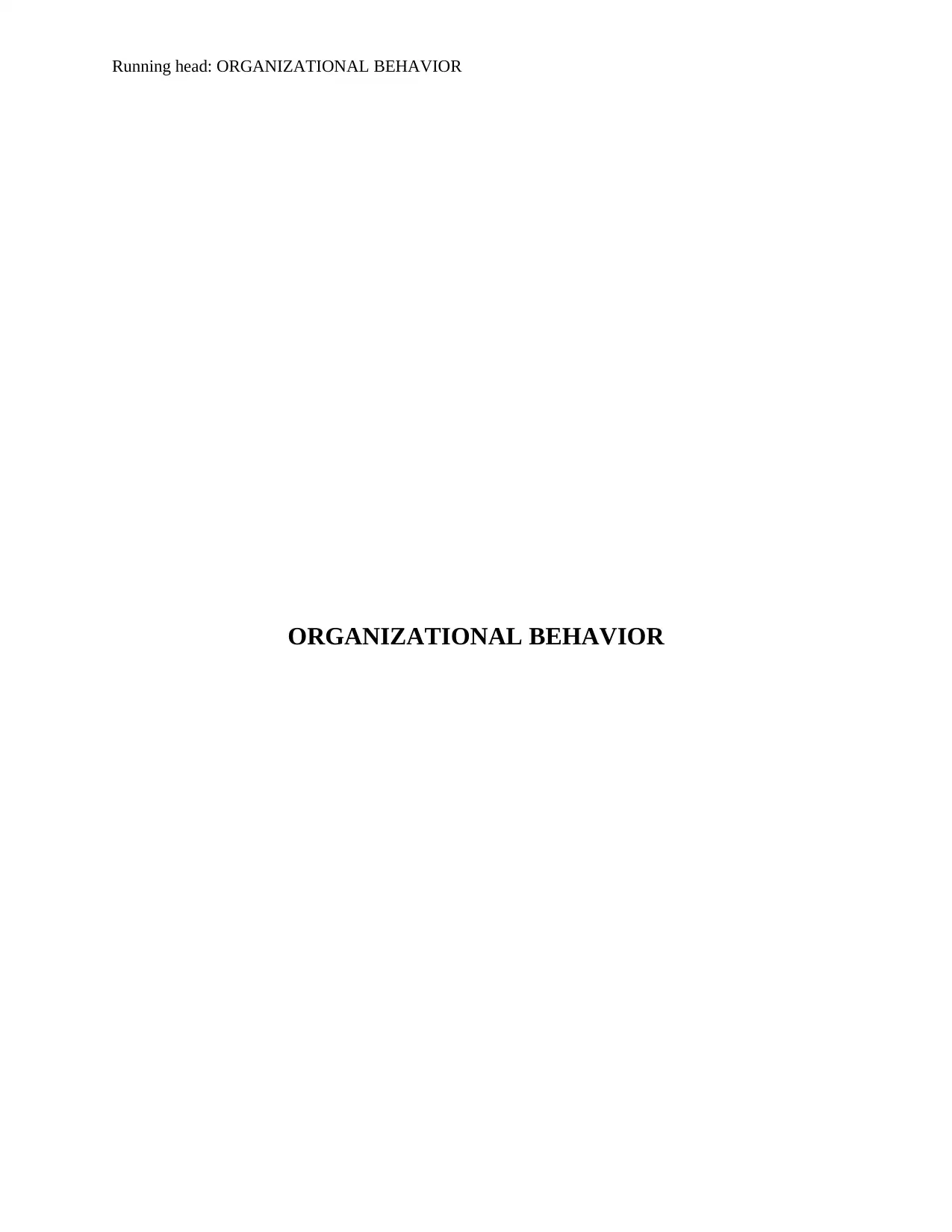
Running head: ORGANIZATIONAL BEHAVIOR
ORGANIZATIONAL BEHAVIOR
ORGANIZATIONAL BEHAVIOR
Paraphrase This Document
Need a fresh take? Get an instant paraphrase of this document with our AI Paraphraser
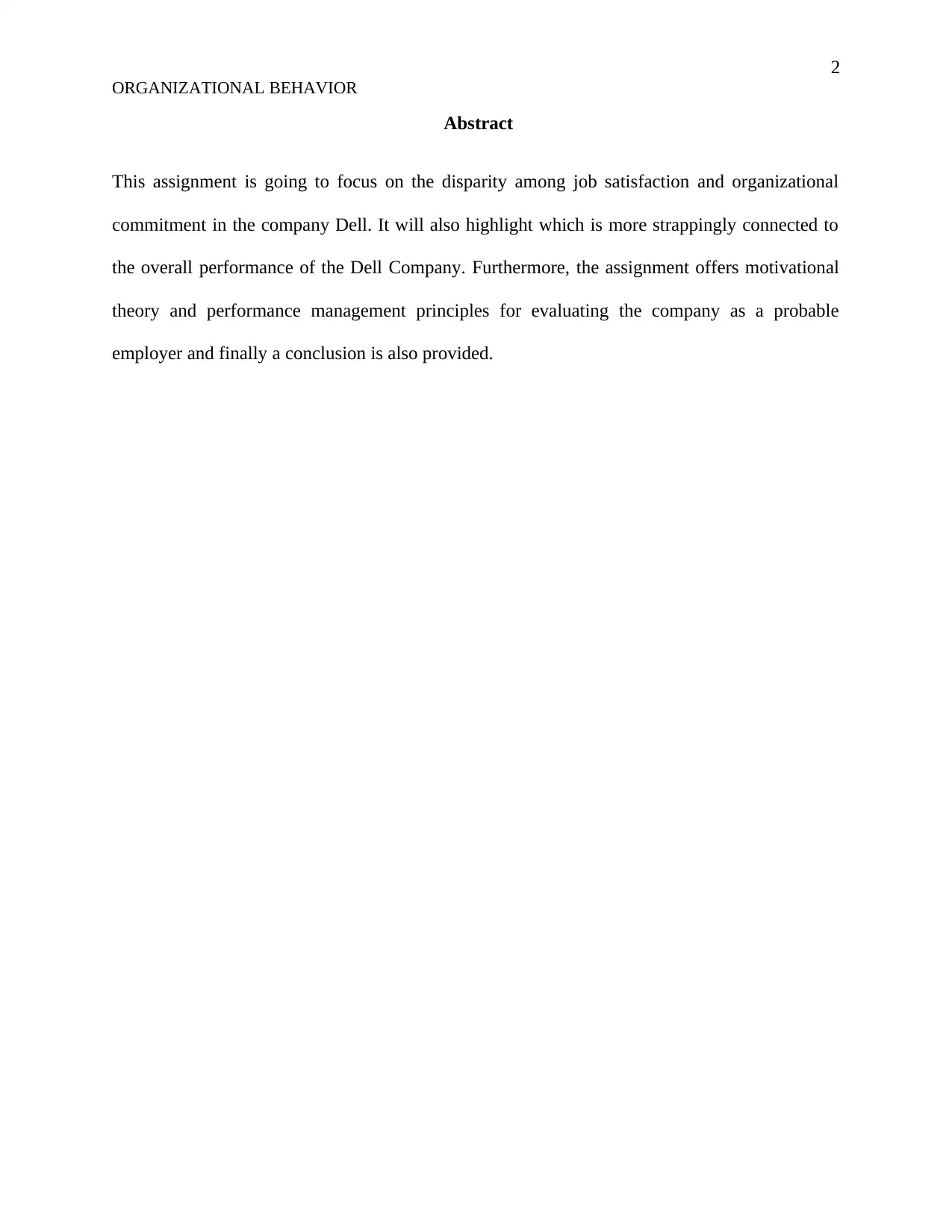
2
ORGANIZATIONAL BEHAVIOR
Abstract
This assignment is going to focus on the disparity among job satisfaction and organizational
commitment in the company Dell. It will also highlight which is more strappingly connected to
the overall performance of the Dell Company. Furthermore, the assignment offers motivational
theory and performance management principles for evaluating the company as a probable
employer and finally a conclusion is also provided.
ORGANIZATIONAL BEHAVIOR
Abstract
This assignment is going to focus on the disparity among job satisfaction and organizational
commitment in the company Dell. It will also highlight which is more strappingly connected to
the overall performance of the Dell Company. Furthermore, the assignment offers motivational
theory and performance management principles for evaluating the company as a probable
employer and finally a conclusion is also provided.
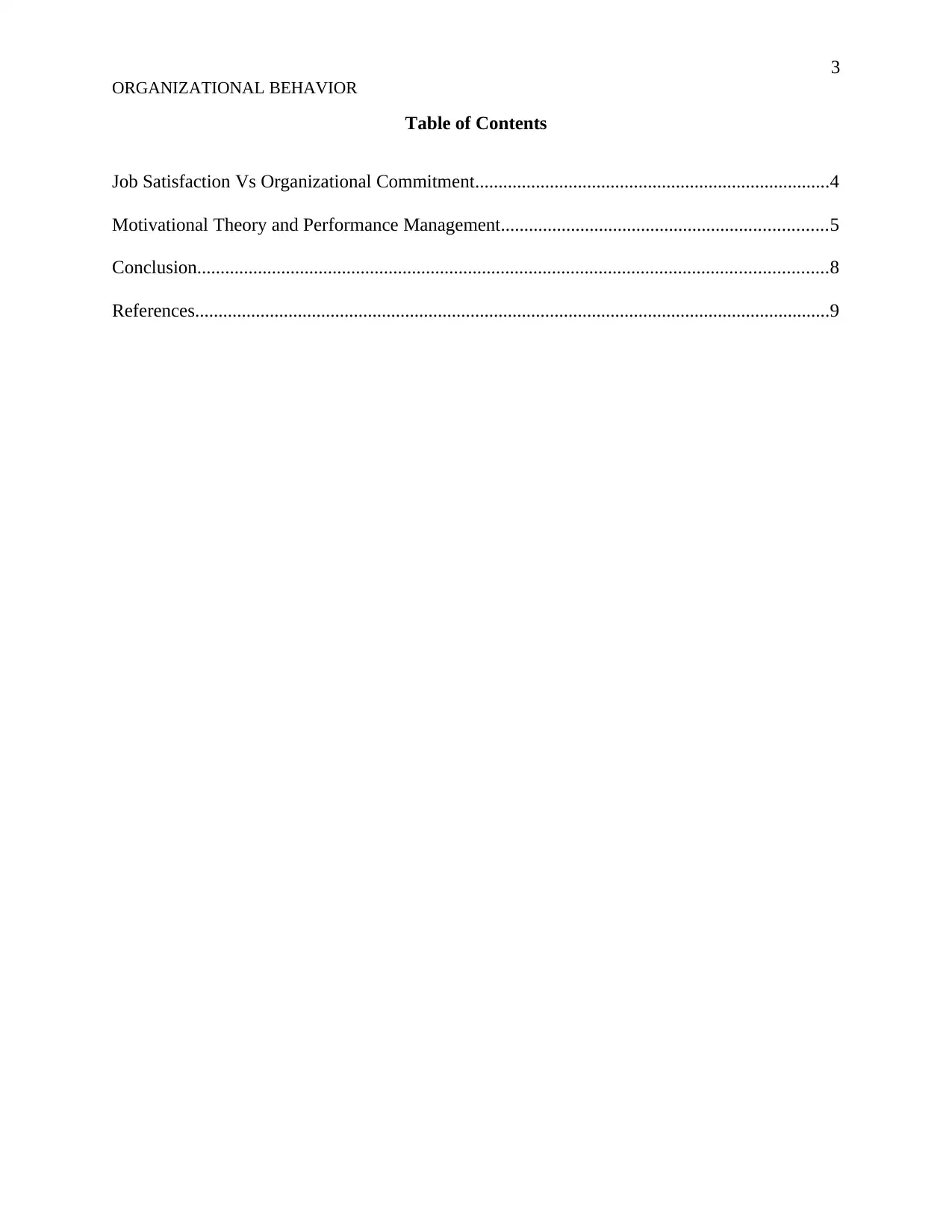
3
ORGANIZATIONAL BEHAVIOR
Table of Contents
Job Satisfaction Vs Organizational Commitment............................................................................4
Motivational Theory and Performance Management......................................................................5
Conclusion.......................................................................................................................................8
References........................................................................................................................................9
ORGANIZATIONAL BEHAVIOR
Table of Contents
Job Satisfaction Vs Organizational Commitment............................................................................4
Motivational Theory and Performance Management......................................................................5
Conclusion.......................................................................................................................................8
References........................................................................................................................................9
⊘ This is a preview!⊘
Do you want full access?
Subscribe today to unlock all pages.

Trusted by 1+ million students worldwide
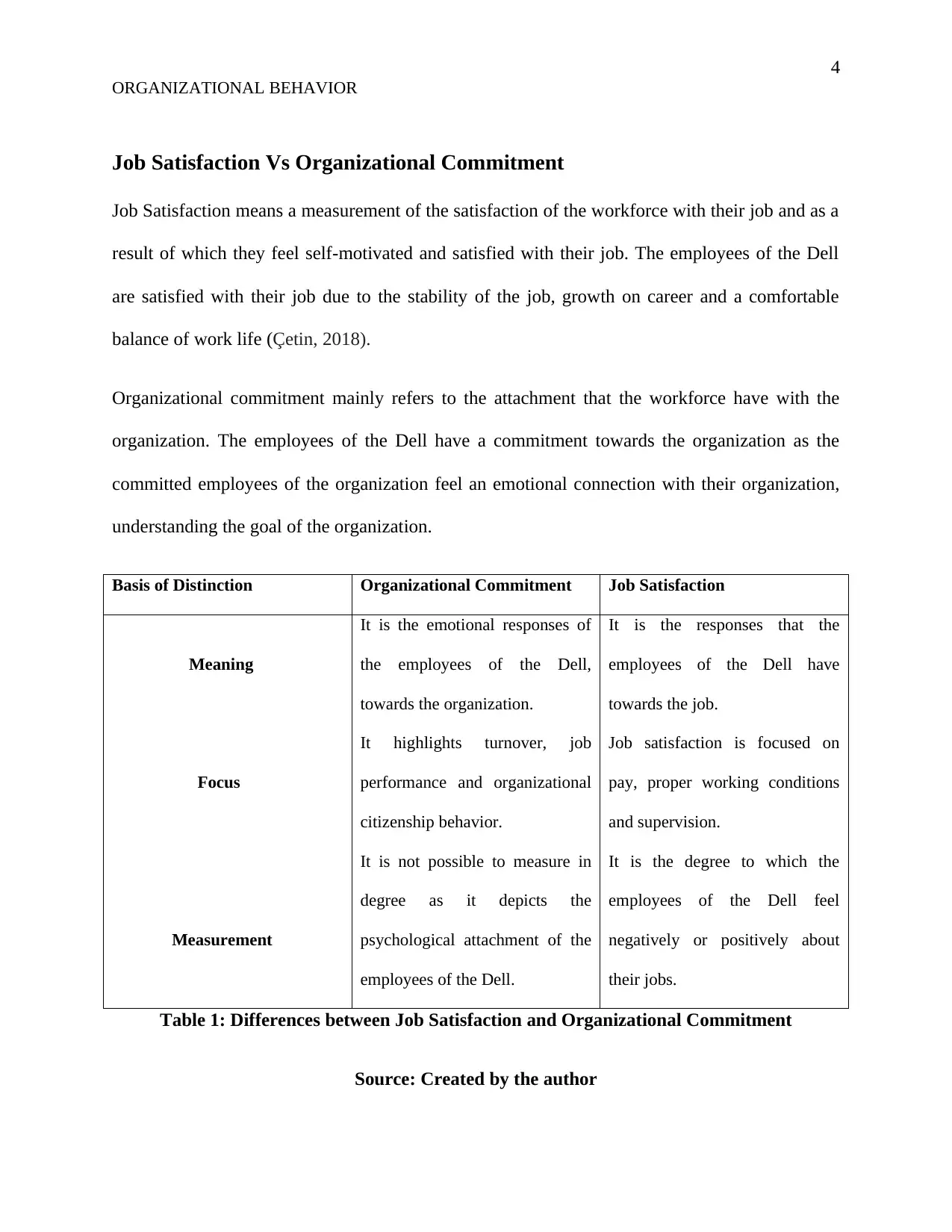
4
ORGANIZATIONAL BEHAVIOR
Job Satisfaction Vs Organizational Commitment
Job Satisfaction means a measurement of the satisfaction of the workforce with their job and as a
result of which they feel self-motivated and satisfied with their job. The employees of the Dell
are satisfied with their job due to the stability of the job, growth on career and a comfortable
balance of work life (Çetin, 2018).
Organizational commitment mainly refers to the attachment that the workforce have with the
organization. The employees of the Dell have a commitment towards the organization as the
committed employees of the organization feel an emotional connection with their organization,
understanding the goal of the organization.
Basis of Distinction Organizational Commitment Job Satisfaction
Meaning
Focus
Measurement
It is the emotional responses of
the employees of the Dell,
towards the organization.
It highlights turnover, job
performance and organizational
citizenship behavior.
It is not possible to measure in
degree as it depicts the
psychological attachment of the
employees of the Dell.
It is the responses that the
employees of the Dell have
towards the job.
Job satisfaction is focused on
pay, proper working conditions
and supervision.
It is the degree to which the
employees of the Dell feel
negatively or positively about
their jobs.
Table 1: Differences between Job Satisfaction and Organizational Commitment
Source: Created by the author
ORGANIZATIONAL BEHAVIOR
Job Satisfaction Vs Organizational Commitment
Job Satisfaction means a measurement of the satisfaction of the workforce with their job and as a
result of which they feel self-motivated and satisfied with their job. The employees of the Dell
are satisfied with their job due to the stability of the job, growth on career and a comfortable
balance of work life (Çetin, 2018).
Organizational commitment mainly refers to the attachment that the workforce have with the
organization. The employees of the Dell have a commitment towards the organization as the
committed employees of the organization feel an emotional connection with their organization,
understanding the goal of the organization.
Basis of Distinction Organizational Commitment Job Satisfaction
Meaning
Focus
Measurement
It is the emotional responses of
the employees of the Dell,
towards the organization.
It highlights turnover, job
performance and organizational
citizenship behavior.
It is not possible to measure in
degree as it depicts the
psychological attachment of the
employees of the Dell.
It is the responses that the
employees of the Dell have
towards the job.
Job satisfaction is focused on
pay, proper working conditions
and supervision.
It is the degree to which the
employees of the Dell feel
negatively or positively about
their jobs.
Table 1: Differences between Job Satisfaction and Organizational Commitment
Source: Created by the author
Paraphrase This Document
Need a fresh take? Get an instant paraphrase of this document with our AI Paraphraser
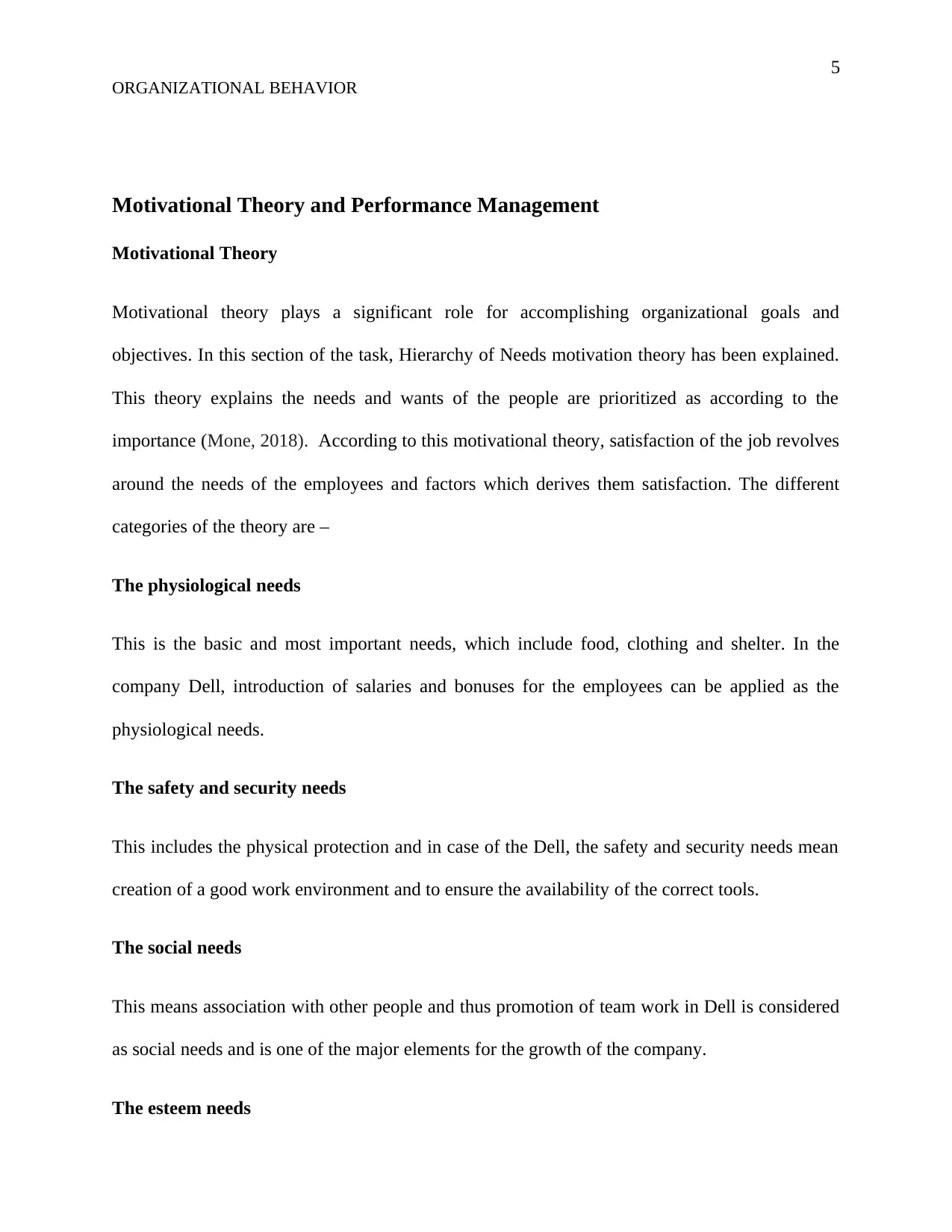
5
ORGANIZATIONAL BEHAVIOR
Motivational Theory and Performance Management
Motivational Theory
Motivational theory plays a significant role for accomplishing organizational goals and
objectives. In this section of the task, Hierarchy of Needs motivation theory has been explained.
This theory explains the needs and wants of the people are prioritized as according to the
importance (Mone, 2018). According to this motivational theory, satisfaction of the job revolves
around the needs of the employees and factors which derives them satisfaction. The different
categories of the theory are –
The physiological needs
This is the basic and most important needs, which include food, clothing and shelter. In the
company Dell, introduction of salaries and bonuses for the employees can be applied as the
physiological needs.
The safety and security needs
This includes the physical protection and in case of the Dell, the safety and security needs mean
creation of a good work environment and to ensure the availability of the correct tools.
The social needs
This means association with other people and thus promotion of team work in Dell is considered
as social needs and is one of the major elements for the growth of the company.
The esteem needs
ORGANIZATIONAL BEHAVIOR
Motivational Theory and Performance Management
Motivational Theory
Motivational theory plays a significant role for accomplishing organizational goals and
objectives. In this section of the task, Hierarchy of Needs motivation theory has been explained.
This theory explains the needs and wants of the people are prioritized as according to the
importance (Mone, 2018). According to this motivational theory, satisfaction of the job revolves
around the needs of the employees and factors which derives them satisfaction. The different
categories of the theory are –
The physiological needs
This is the basic and most important needs, which include food, clothing and shelter. In the
company Dell, introduction of salaries and bonuses for the employees can be applied as the
physiological needs.
The safety and security needs
This includes the physical protection and in case of the Dell, the safety and security needs mean
creation of a good work environment and to ensure the availability of the correct tools.
The social needs
This means association with other people and thus promotion of team work in Dell is considered
as social needs and is one of the major elements for the growth of the company.
The esteem needs
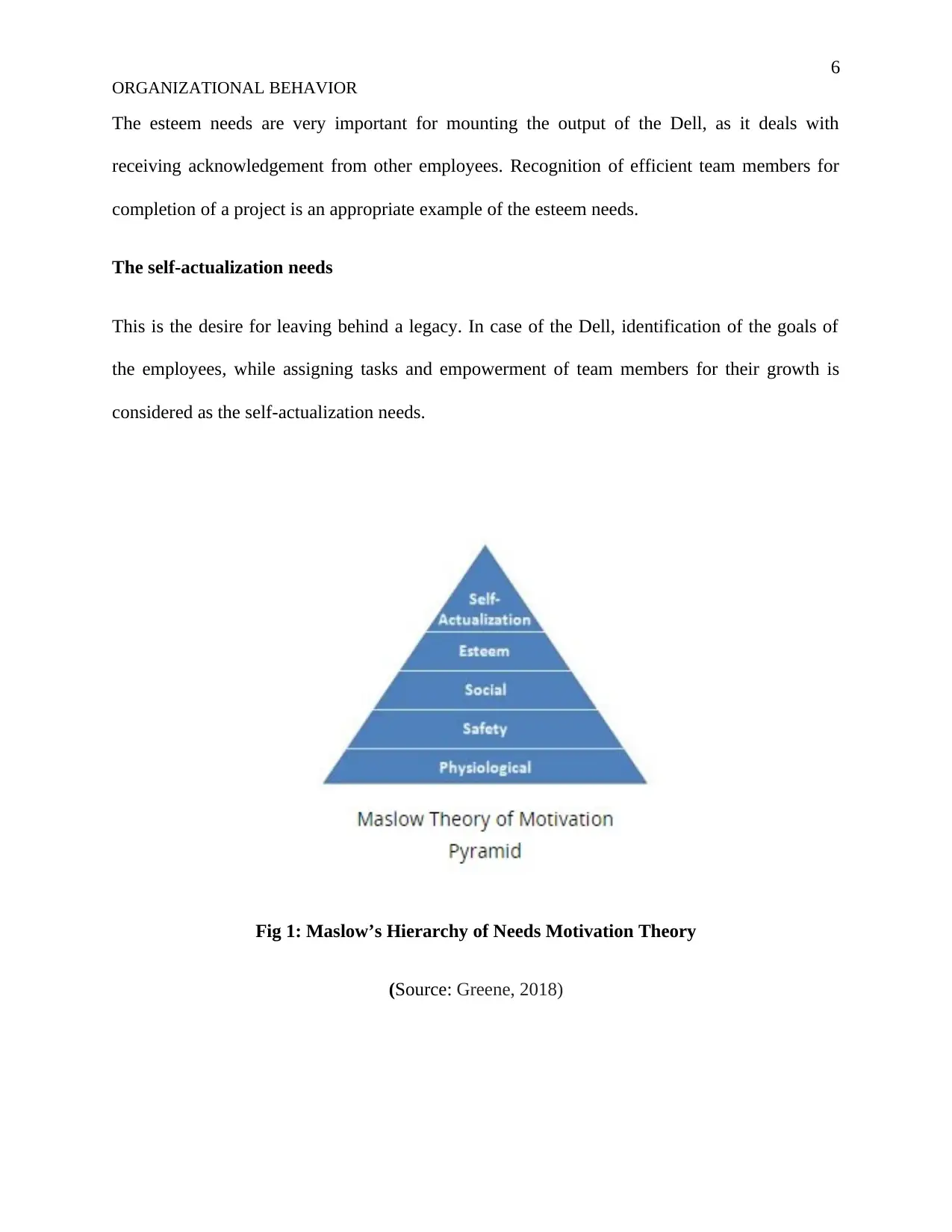
6
ORGANIZATIONAL BEHAVIOR
The esteem needs are very important for mounting the output of the Dell, as it deals with
receiving acknowledgement from other employees. Recognition of efficient team members for
completion of a project is an appropriate example of the esteem needs.
The self-actualization needs
This is the desire for leaving behind a legacy. In case of the Dell, identification of the goals of
the employees, while assigning tasks and empowerment of team members for their growth is
considered as the self-actualization needs.
Fig 1: Maslow’s Hierarchy of Needs Motivation Theory
(Source: Greene, 2018)
ORGANIZATIONAL BEHAVIOR
The esteem needs are very important for mounting the output of the Dell, as it deals with
receiving acknowledgement from other employees. Recognition of efficient team members for
completion of a project is an appropriate example of the esteem needs.
The self-actualization needs
This is the desire for leaving behind a legacy. In case of the Dell, identification of the goals of
the employees, while assigning tasks and empowerment of team members for their growth is
considered as the self-actualization needs.
Fig 1: Maslow’s Hierarchy of Needs Motivation Theory
(Source: Greene, 2018)
⊘ This is a preview!⊘
Do you want full access?
Subscribe today to unlock all pages.

Trusted by 1+ million students worldwide
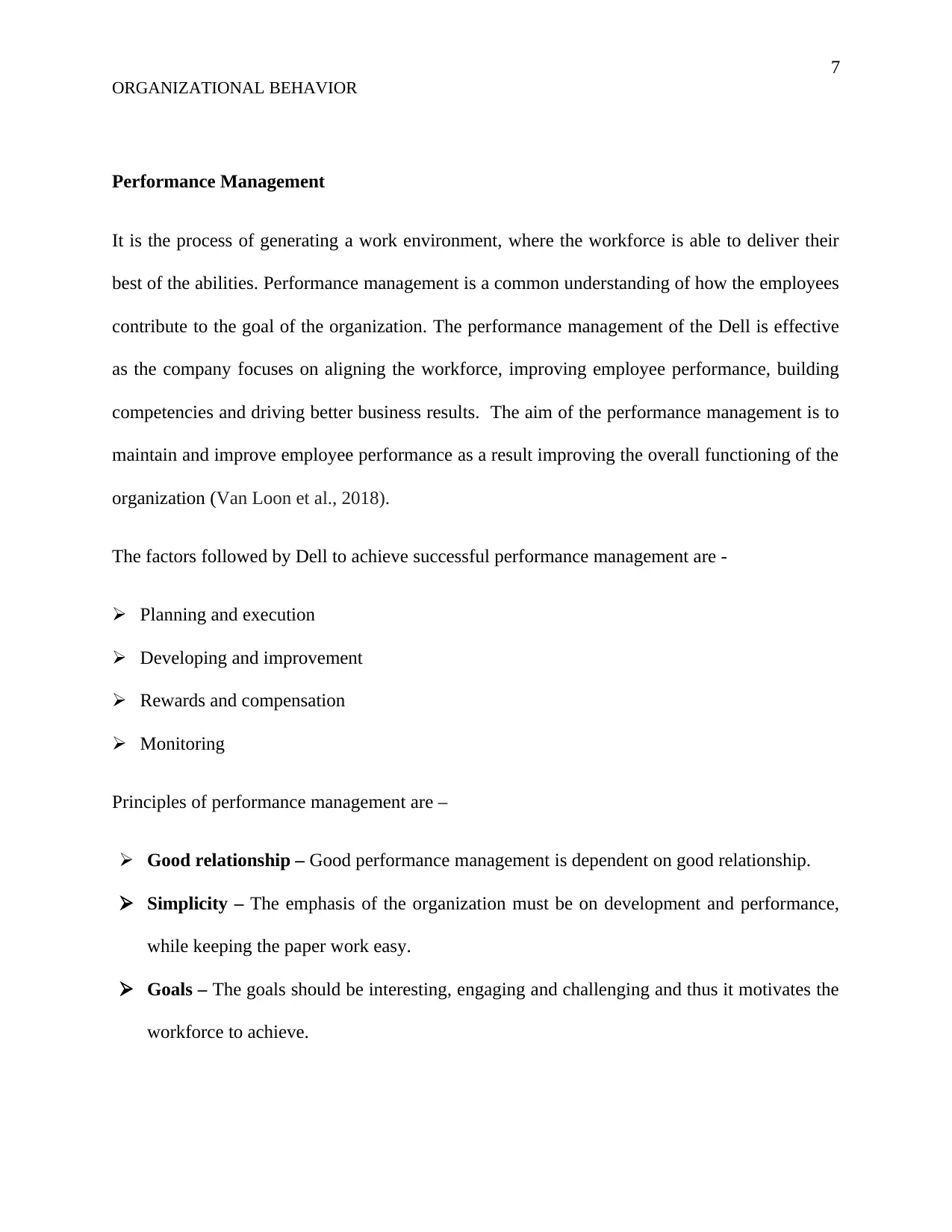
7
ORGANIZATIONAL BEHAVIOR
Performance Management
It is the process of generating a work environment, where the workforce is able to deliver their
best of the abilities. Performance management is a common understanding of how the employees
contribute to the goal of the organization. The performance management of the Dell is effective
as the company focuses on aligning the workforce, improving employee performance, building
competencies and driving better business results. The aim of the performance management is to
maintain and improve employee performance as a result improving the overall functioning of the
organization (Van Loon et al., 2018).
The factors followed by Dell to achieve successful performance management are -
Planning and execution
Developing and improvement
Rewards and compensation
Monitoring
Principles of performance management are –
Good relationship – Good performance management is dependent on good relationship.
Simplicity – The emphasis of the organization must be on development and performance,
while keeping the paper work easy.
Goals – The goals should be interesting, engaging and challenging and thus it motivates the
workforce to achieve.
ORGANIZATIONAL BEHAVIOR
Performance Management
It is the process of generating a work environment, where the workforce is able to deliver their
best of the abilities. Performance management is a common understanding of how the employees
contribute to the goal of the organization. The performance management of the Dell is effective
as the company focuses on aligning the workforce, improving employee performance, building
competencies and driving better business results. The aim of the performance management is to
maintain and improve employee performance as a result improving the overall functioning of the
organization (Van Loon et al., 2018).
The factors followed by Dell to achieve successful performance management are -
Planning and execution
Developing and improvement
Rewards and compensation
Monitoring
Principles of performance management are –
Good relationship – Good performance management is dependent on good relationship.
Simplicity – The emphasis of the organization must be on development and performance,
while keeping the paper work easy.
Goals – The goals should be interesting, engaging and challenging and thus it motivates the
workforce to achieve.
Paraphrase This Document
Need a fresh take? Get an instant paraphrase of this document with our AI Paraphraser

8
ORGANIZATIONAL BEHAVIOR
Conclusion
This assignment has highlighted the differences between job satisfaction and organizational
commitment at Dell. It also has applied motivational theory and performance management
principles to evaluate the company as a potential employer.
ORGANIZATIONAL BEHAVIOR
Conclusion
This assignment has highlighted the differences between job satisfaction and organizational
commitment at Dell. It also has applied motivational theory and performance management
principles to evaluate the company as a potential employer.
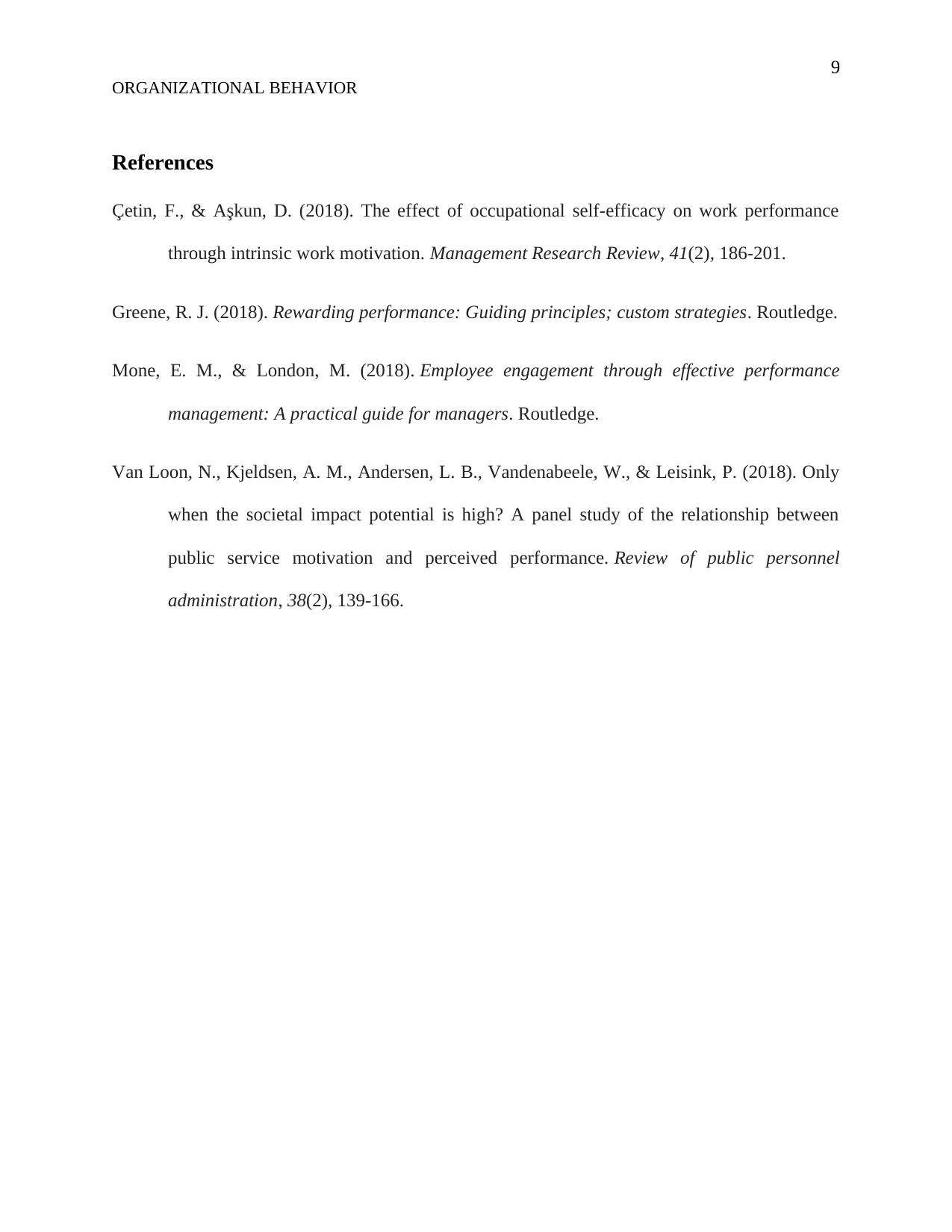
9
ORGANIZATIONAL BEHAVIOR
References
Çetin, F., & Aşkun, D. (2018). The effect of occupational self-efficacy on work performance
through intrinsic work motivation. Management Research Review, 41(2), 186-201.
Greene, R. J. (2018). Rewarding performance: Guiding principles; custom strategies. Routledge.
Mone, E. M., & London, M. (2018). Employee engagement through effective performance
management: A practical guide for managers. Routledge.
Van Loon, N., Kjeldsen, A. M., Andersen, L. B., Vandenabeele, W., & Leisink, P. (2018). Only
when the societal impact potential is high? A panel study of the relationship between
public service motivation and perceived performance. Review of public personnel
administration, 38(2), 139-166.
ORGANIZATIONAL BEHAVIOR
References
Çetin, F., & Aşkun, D. (2018). The effect of occupational self-efficacy on work performance
through intrinsic work motivation. Management Research Review, 41(2), 186-201.
Greene, R. J. (2018). Rewarding performance: Guiding principles; custom strategies. Routledge.
Mone, E. M., & London, M. (2018). Employee engagement through effective performance
management: A practical guide for managers. Routledge.
Van Loon, N., Kjeldsen, A. M., Andersen, L. B., Vandenabeele, W., & Leisink, P. (2018). Only
when the societal impact potential is high? A panel study of the relationship between
public service motivation and perceived performance. Review of public personnel
administration, 38(2), 139-166.
⊘ This is a preview!⊘
Do you want full access?
Subscribe today to unlock all pages.

Trusted by 1+ million students worldwide
1 out of 9
Related Documents
Your All-in-One AI-Powered Toolkit for Academic Success.
+13062052269
info@desklib.com
Available 24*7 on WhatsApp / Email
![[object Object]](/_next/static/media/star-bottom.7253800d.svg)
Unlock your academic potential
Copyright © 2020–2025 A2Z Services. All Rights Reserved. Developed and managed by ZUCOL.




